Hummingbirds Will Fall in Love With Rose of Sharon
Updated: Feb. 22, 2024
A rose of Sharon shrub has large, gorgeous flowers that attract pollinators in droves, including bees, butterflies and hummingbirds.
On This Page
Do Hummingbirds Like Rose of Sharon?
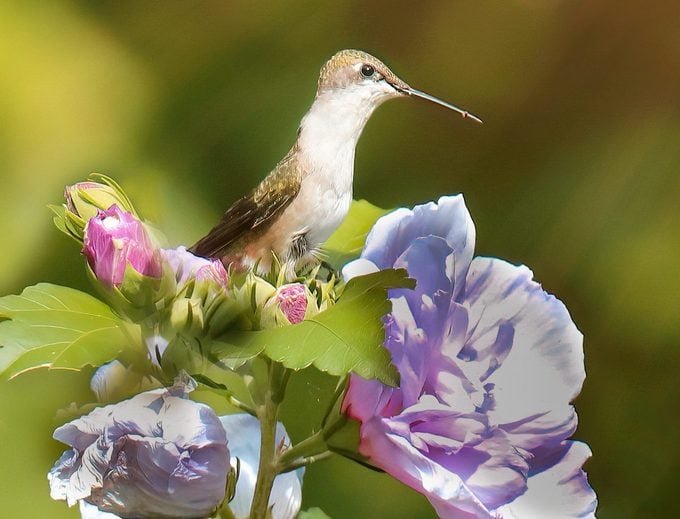
On a recent trip to Michigan to visit family, I was captivated by the rose of Sharon (Hibiscus syriacus) bush in their front yard. It was a magnet for everything with wings! One afternoon, I dragged a lawn chair into the shade by the bush to watch for about an hour to see what visitors I could spot. I quickly learned that rose of Sharon attracts hummingbirds, butterflies and plenty more pollinators including bees, wasps and flies.
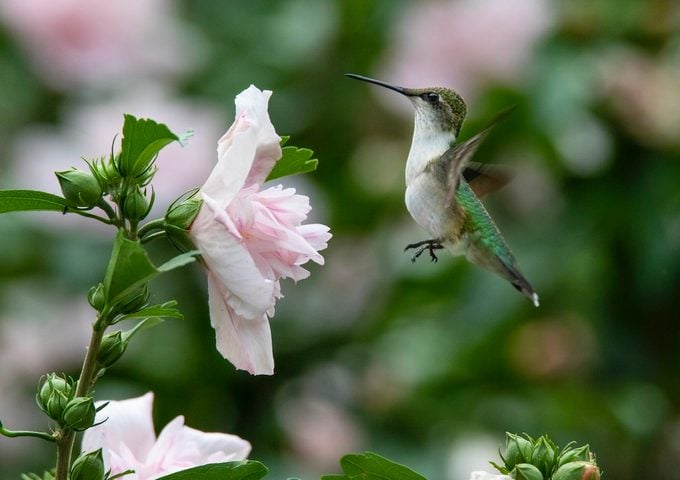
I also spotted many butterflies using the flowers for nectar, including a giant swallowtail, great spangled fritillary, and cabbage white. Dragonflies were using the branches to perch, and small songbirds flitted in and out of the shelter of the branches. It was simply amazing how this one small shrub was providing food and shelter for so many different backyard species all at once.
Check out the top 15 colorful hummingbird flowers to grow.
Rose of Sharon Care
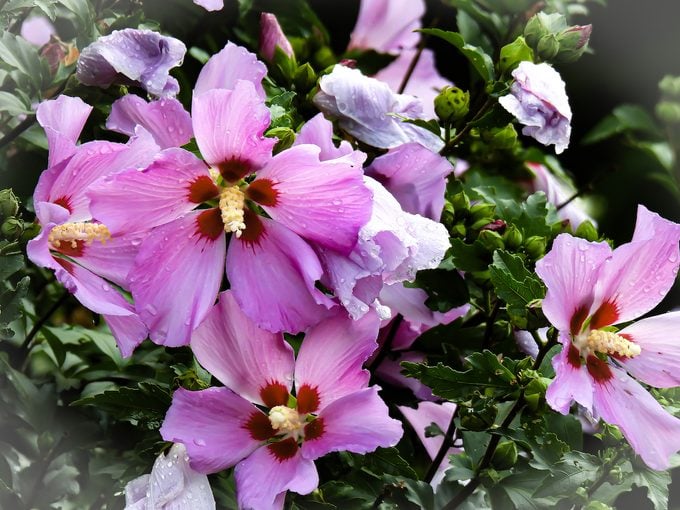
Native to Asia, rose of Sharon is usually grown in the U.S. in zones 5 to 8. It blooms from summer through fall and is easy to grow in most soils and conditions. You can prune it into a hedge or tree form, or let it ramble wild. Look for multiple cultivars at your local garden center, or ask a friend or neighbor for a stem cutting to root.
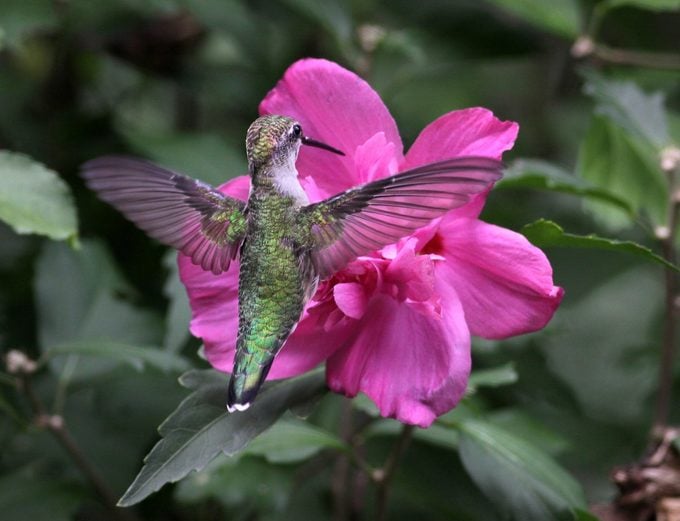
- Rose of Sharon
- Hibiscus syriacus
- Zones: 5 to 8
- Size: 8 to 12 feet tall and 6 to 10 feet wide
- Light needs: Full to partial sun
- Soil: Moist, well-draining soil
- Flower color: white, pink, red, purple, blue or violet
- Attracts: hummingbirds, bees, butterflies
- Bloom time: Late summer to mid-autumn
This is the hibiscus to grow if others have failed you. In the right conditions, the upright shrub reaches 12 feet tall, creating an excellent privacy screen or focal point. Watch for Japanese beetles, which can cause serious foliage damage.
Rose of Sharon Varieties to Grow
Choose pure white, 9-foot-tall Diana or one of the 6-foot Chateau varieties, whose multiple stems are lined completely with pink, white or rosy purple blossoms from summer to fall. Another cultivar we love, Blue Bird, has a contrasting deep burgundy center and bright white stamen.
Learn how to attract hummingbirds to a small garden.
Rose of Sharon Not Blooming
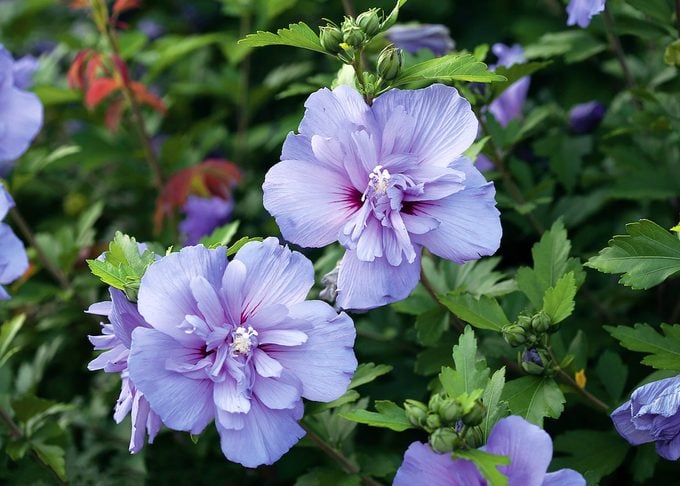
“Two rose of Sharon plants grow side by side in my garden. One blooms prolifically, but the other not so much. I’ve experimented with fertilizers, but the blooms just bud and never open. Why is that?” asks Birds & Blooms reader Don Buehler of Yardley, Pennsylvania.
Gardening expert Melinda Myers says, “Many gardeners report the same problem with their rose of Sharon shrubs. New plantings seem to be the most susceptible, as they are focusing energy on establishing a robust root system instead of on the flowers. Fluctuations in soil moisture, hot temperatures and other plant stressors can contribute to bud drop. Mulch the soil and provide consistent moisture throughout the growing season. Avoid overfertilization, which can interfere with flowering and promote lush succulent growth that certain insects, such as aphids, prefer to dine on.
Aphids, thrips and midges can stress the plants and result in bud drop. Use a strong blast of water to dislodge aphids.
Your shrub may also be producing more flowers than the plant can support. Plants often shed excess flowers and fruit when this occurs, which has led some experts to recommend removing all but two or three buds per stem.
A fungal disease, botrytis blight, can infect flower buds, causing them to turn brown and drop to the ground before opening. Remove and destroy botrytis-infected buds to reduce the risk for next year. Discarding dropped buds that may contain midges is also helpful.
Always confirm the exact cause if you decide to chemically control an insect or disease pest. Rose of Sharon flowers are a favorite of hummingbirds and bees, so you do not want to harm them when trying to manage a problem.”
Hydrangea not blooming? Here’s what to do.
Winter Hardiness and Pruning
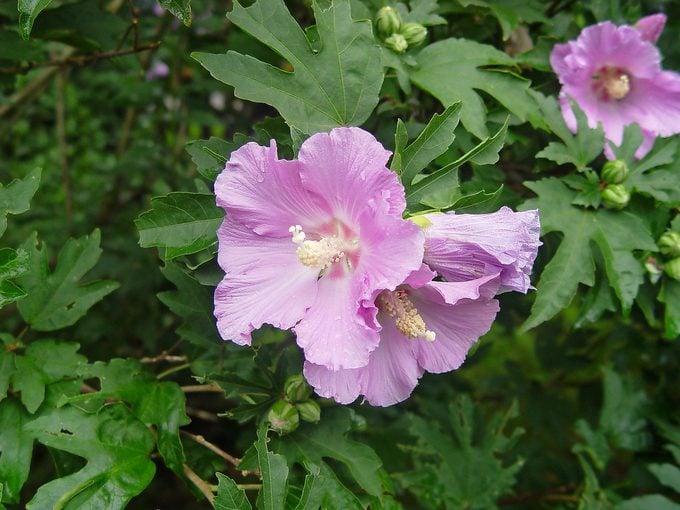
“I planted three perennial hibiscus shrubs, and I’ve read conflicting stories about pruning and winterizing. What is the right way to care for them?” asks reader Kathryn Small of Simpsonville, Kentucky.
Melinda says, “I assume you are speaking of Hibiscus syriacus, commonly called rose of Sharon or shrub althea. It is hardy in Zones 5 to 8 or 9, although it may suffer severe injury or death when temperatures dip to 20 degrees below zero. Proper siting and care should be sufficient to prepare these plants for your winter. Prune young plants to encourage balanced growth and branching if needed.
Once established, these plants need minimal pruning. Just remove any winter dieback. Because this plant blooms on new growth, it can be pruned anytime during the dormant season. I prefer late winter or early spring before growth begins. That way you can remove any winter injury while managing the size and shape of the plant.”
Learn how to prepare and prune roses for winter.
Is Rose of Sharon Invasive?
One word of caution: this non-native shrub is considered invasive in some areas. If you’re concerned, check with your local extension office to find out if this flowering bush is right for your yard. Also look for seedless cultivars like Sugar Tip.
Psst—never plant these invasive shrubs (and what to grow instead!)
Sources
- Proven Winners
- Monrovia
About the Expert
Melinda Myers is the official gardening expert for Birds & Blooms. She is a TV/radio host, author and columnist who has written more than 20 gardening books. Melinda earned a master’s degree in horticulture from the University of Wisconsin-Madison.
Why Trust Us?
For nearly 30 years, Birds & Blooms, a Trusted Media Brand, has been inspiring readers to have a lifelong love of birding, gardening and nature. We are the #1 bird and garden magazine in North America and a trusted online resource for over 15 million outdoor enthusiasts annually. Our library of thousands of informative articles and how-tos has been written by trusted journalists and fact-checked by bird and garden experts for accuracy. In addition to our staff of experienced gardeners and bird-watchers, we hire individuals who have years of education and hands-on experience with birding, bird feeding, gardening, butterflies, bugs and more. Learn more about Birds & Blooms, our field editor program, and our submission guidelines.
